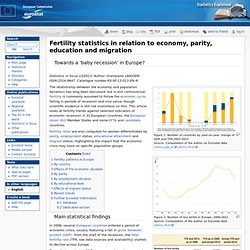

Ageing and welfare state policies. Population Europe. The World in 2015: Global population and the changing shape of world demographics. Glossary of Demographic Terms. Abortion Rate The number of abortions per 1,000 women ages 15-44 or 15-49 in a given year.

Abortion Ratio The number of abortions per 1,000 live births in a given year. Acquired Immunodeficiency Syndrome (AIDS) Applies to the most advanced stages of HIV infection. It is defined by the occurrence of any of more than 20 opportunistic infections or HIV-related cancers. Age-Dependency Ratio The ratio of persons in the ages defined as dependent (under 15 years and over 64 years) to persons in the ages defined as economically productive (15-64 years) in a population. Age-Sex Structure The composition of a population as determined by the number or proportion of males and females in each age category.
Age-Specific Rate Rate obtained for specific age groups (for example, age-specific fertility rate, death rate, marriage rate, illiteracy rate, or school enrollment rate). Antiretroviral therapy (ART) Treatment of people infected with human immunodeficiency virus (HIV) using anti-HIV drugs. List of sovereign states and dependent territories by fertility rate. A world map showing countries by fertility rate (2014) - according to CIA World Factbook of 2014 This is a list of all countries and dependent territories by total fertility rate (TFR): the expected number of children born per woman in her child-bearing years.

Methodology[edit] DON'T PANIC — Hans Rosling showing the facts about population. Population Pyramids of the World from 1950 to 2100 — PopulationPyramid.net. Under the raedar: The Geography of New York City. In June 2013, the city of New York released as open data one of the most detailed, fascinating and user-friendly datasets ever.

The Property Land Use Tax lot Output (PLUTO) dataset is essentially a record of every parcel of land in the city, what is on it and who owns it - but this is only part of it. See the full PLUTO data dictionary for more on this. Wired said the mapping elite were 'drooling' over it and there have been a few impressive visualisations already but I was keen to look at the data in more detail and then map land use patterns and get to grips with the dataset more generally. So, as an initial experiment, I mapped all 11 land use categories for the whole city in 3D (PLUTO has a field for number of floors so the maps below are extruded on this basis). Click on an image to enlarge and then flick through the images to compare land uses. I've also put these images in a PowerPoint file in case anyone finds it useful... Some further information about the dataset. Demographic Winter. Human Population.
Author and Page information by Anup ShahThis Page Last Updated Thursday, June 13, 2002 "Go Forth And Multiply!

" That's what the human population has successfully been doing for thousands and thousands of years, expanding, exploring, migrating, conquering, utilizing, evolving, civilizing, industrializing, and now, destroying the very land upon which we live. Many feel (as has been the case throughout history) that the major international wars to be fought in the future will continue to be over natural resources. World Fertility Data 2008: Data. List of sovereign states and dependent territories by fertility rate. Falling Birth Rates? Demographics, ageing population. Impact consumers, brands, marketing speaker.
Thomas Malthus: Theory of Population. Thomas Robert Malthus was a British economist and a demographer, whose famous Theory of Population highlighted the potential dangers of overpopulation.

Malthus put forth his ideas in six editions of his famous treatise 'An Essay on the Principle of Population'. His thinking took shape under the influence of the optimistic ideas of his father and his friends especially Rousseau, for future improvement of the society. In the first edition of his treatise, Malthus put forth his views that opposed the belief of scholars like Marquis de Condorcet and William Godwin who were optimistic about population growth in England. During the Industrial Revolution, England experienced a steep increase in its population. In his book "The Enquirer", William Godwin promoted population growth as a means for human beings to attain equality. The Theory According to him, human society could never be perfected. Assumptions Relation Between Population, Wages and Inflation Proposed Solutions Impact. Is population growth out of control? The respected broadcaster and naturalist, Sir David Attenborough, told the BBC recently that population growth was "out of control" - but one expert says the number of people on the planet could peak in 40 years.

Who should we believe? "The world's population is increasing out of control," Sir David told the BBC's Today programme. "Since I first started making programmes 60 years ago, the human population has tripled. " Two striking claims. Hans Rosling: Global population growth, box by box. Distilled Demographics: The Birth Rate. Nobody Home: The Countries Where Population Is on the Decline - TIME Special Report: The World at 7 Billion. The global population may have increased by an unprecedented one billion in the past 12 years, but not all parts of the planet are sharing in the people boom.

In fact, some nations are in the midst of the just the opposite: large-scale population decline. They are mostly former Soviet Republics and Eastern European countries. According to the latest U.N. count, of the 24 nations that registered population falls between 2005 and 2010 only Puerto Rico, Germany and some small island nations were not from this region. The Republic of Moldova — with a dwindling population of 3.6 million sandwiched between larger neighbors Ukraine and Romania — tops the global list of big countries' negative growth, with a 1.1% average annual drop over the five-year period. Nearby Bulgaria, Georgia and Ukraine are next on the list, each with declines of 0.6%. Fertility statistics in relation to economy, parity, education and migration. Towards a 'baby recession' in Europe?

Population Pyramids. The Demographic Transition Model. Demographic Transition and Growth in Kenya. Kenya’s population has doubled over the last 25 years, to about 40 million people, and rapid population growth is set to continue.

According to recent UN projections, Kenya’s population will grow by around 1 million per year – 3,000 people every day – over the next 40 years and will reach about 85 million by 2050. These are projections; the actual numbers depend on government policies and the broader economic environment; and they may turn out differently. But in the past population science has proven to be relatively accurate, as social structures and behaviors tend to change gradually. The Demographic Challenge > Demographic change in Japan. Social & Economic Implications of Shrinking Societies: The Case of Japan WDA Expert Symposium, Switzerland, May 23-25, 2012.

What are the arising challenges and how can they be tackled? What does population ageing and decline mean for Japan’s society, its labor markets, its competiveness & productivity, its financial markets and its public budget etc.? What are Japan’s recipes to cope with its unprecedented demographic challenges? What lessons can be learned from Japan in Europe? Broadly speaking, all the developed economies will face demographic slow-downs and unprecedented population aging in the decades to come, but Japan stands to be the most heavily burdened by these upcoming trends. In 2008, the country recorded around 40 % as many births as it had 60 years earlier.
Demographic changes to boost Brazil's investment appeal. In Brazil, we believe a demographic and social phenomenon is underway as a growing proportion of the population enter the most economically active period of their life. Some economists have termed this shift in the population profile of Brazil as a demographic bonus because it is likely to strengthen the dynamics of the domestic economy and further boost the country's development. A recent study by the University of Minas Gerais concluded that Brazil has the potential to grow GDP 2.5% per year as a result of this demographic bonus.
This scenario on its own would increase the size of the economy to $3.3 trillion by 2030, about 50% more than what it is today. A more upbeat and positive scenario, not too unreasonable given the likelihood that the maturing population could be used to drive reforms in areas such as social security and pensions over the next two decades, could see an economy with a GDP of $7 trillion and a per capita income level comparable with Spain today. A maturing nation. Averting a Demographic Nightmare in Russia and Eastern Europe. Over the past 20 years, newspaper readers across the world had grown accustomed to alarming headlines with some variant of “The Russians are Dying Out”.
In the first ten years after the collapse of the Soviet Union, a catastrophic fall in Russia’s birth rate was accompanied by a disturbingly low life expectancy. While Russia continues to experience the negative effects of its post-Soviet demographic slump, the situation is improving noticeably, and the whole post-Communist world should take note. Total fertility rate. Phases of Singapore's Demographic Development Post World War II. From a population of 1 million in 1950, Singapore's resident population, comprising citizens and permanent migrants, has grown more than three and a half times to 3.7 million in 2009 (5.0 million, if foreigners with permits1 are included).
Singapore's demographic change from the late 1940s can be differentiated into three phases characterised by distinct population trends and socioeconomic developments, with a fourth phase now emerging. Throughout Singapore's various demographic phases, direct measures had been put in place to modify fertility behaviour. FAMILY PLANNING: A GROWING EMPOWERMENT OPPORTUNITY FOR WOMEN IN AFGHANISTAN.
Date: 11/03/2013 Use of modern family planning methods in Afghanistan has doubled from 10 percent in 2003 to 20 percent in 2012. Still much more needs to be done in order to achieve the Government of Afghanistan target to increase the Contraceptive Prevalence Rate to 40% by 2016. UNFPA Afghanistan supports the Ministry of Public Health to take steps to meet the family-planning needs and to assist couples and individuals to achieve their reproductive goals and give them the full opportunity to exercise the right to have children by choice.
"It is important and essential that we talk about family planning. In my school nobody knows anything about reproductive health. UNHCR:The UK and Asylum. What is the difference between a refugee and an asylum seeker? What are refugees? A refugee is a person who: 'owing to a well-founded fear of being persecuted for reasons of race, religion, nationality, membership of a particular social group, or political opinion, is outside the country of his nationality, and is unable to or, owing to such fear, is unwilling to avail himself of the protection of that country' Population policies - Ace Geography. Social, Economic and Political Implications of Population change. Don't Panic - The Truth About Population - Geography for 2013 & Beyond. Ageing China: Changes and challenges. China media: One-child policy. 18 November 2013Last updated at 00:50 ET Papers praise relaxation in China's one-child policy Media welcome reforms to relax the one-child policy and abolish a controversial labour camp system, but raise concerns over their effectiveness.
A new plan allowing couples in China to have two children if one of the parents is an only child is continuing to reverberate through the media since its announcement on Friday. China reforms: One-child policy to be relaxed. Introduction. How the Total Fertility Rate Impacts a Country's Population. The term total fertility rate is used to describe the total number of children the average women in a population is likely to have based on current birth rates throughout her life. The number, which ranges from more than 7 children per woman in developing countries in Africa to around 1 child per woman in Eastern European and highly-developed Asian countries. Crude Birth Rate (CBR) and Crude Death Rate (CBR)